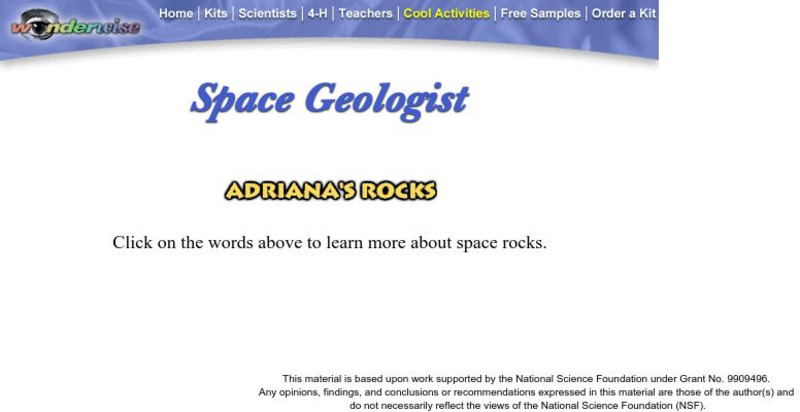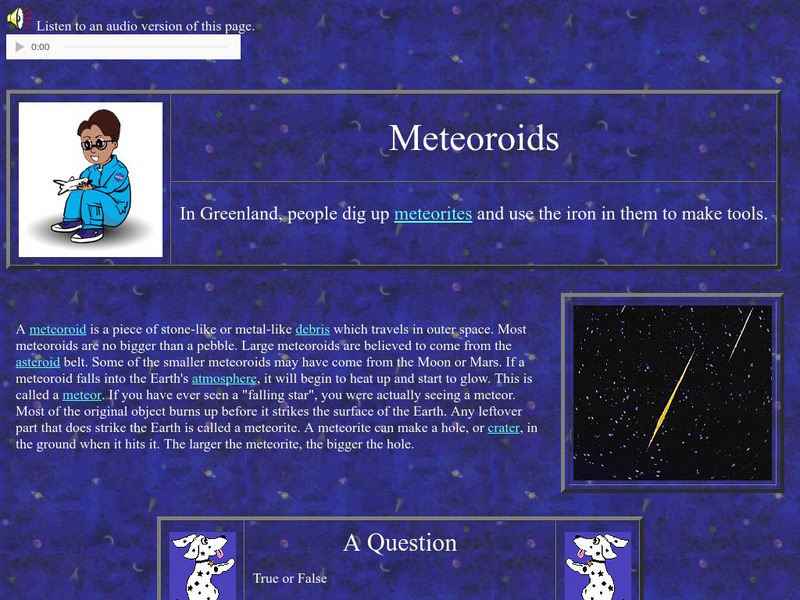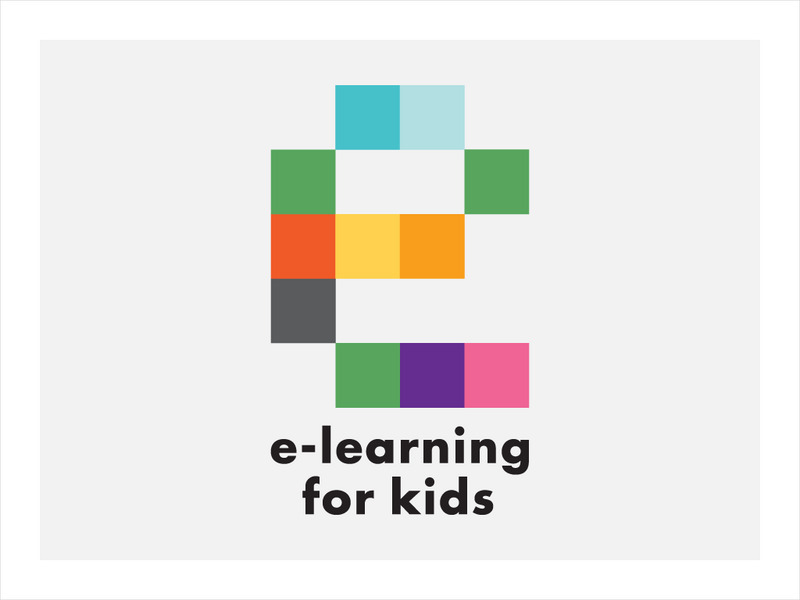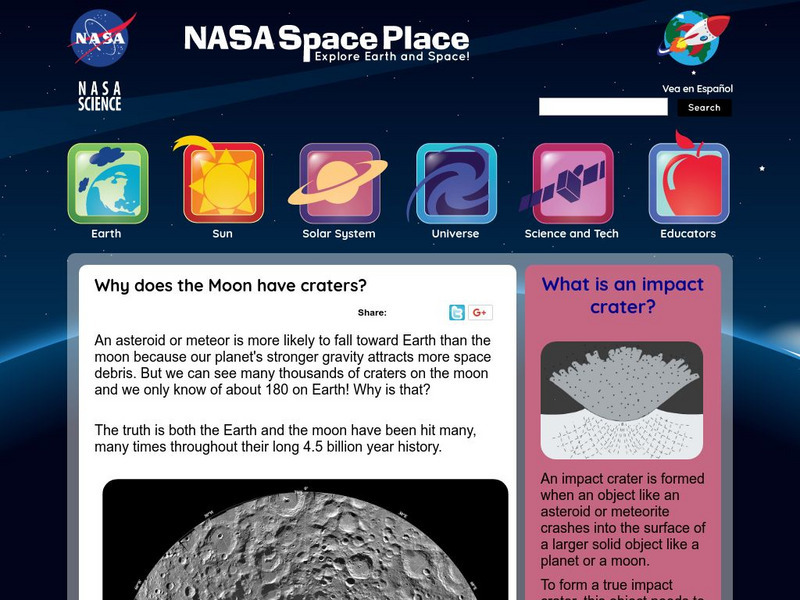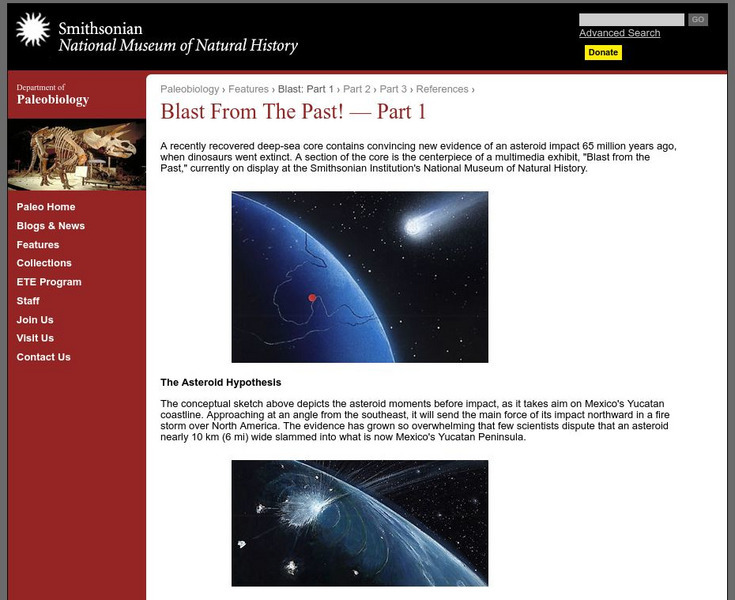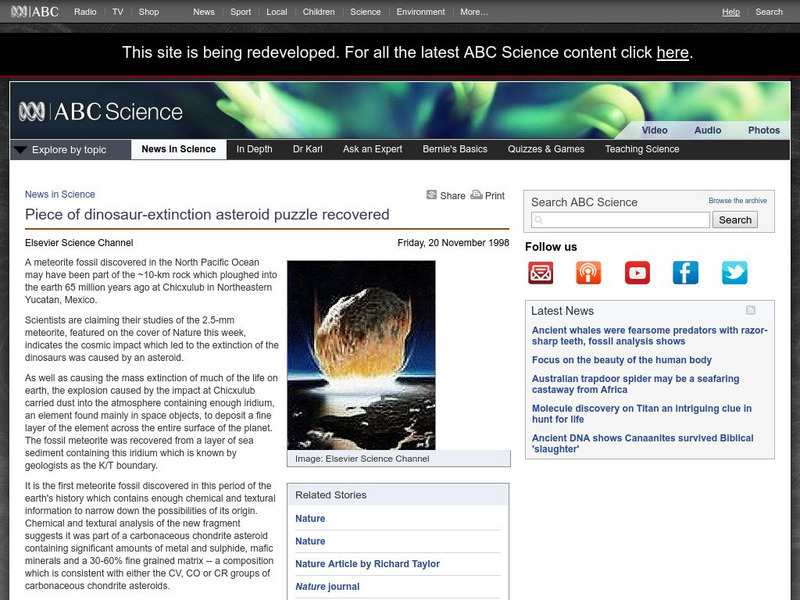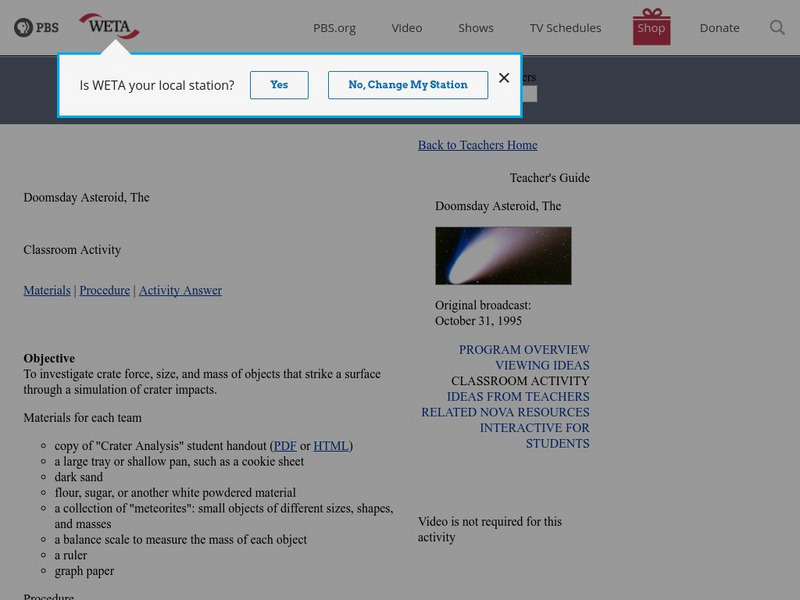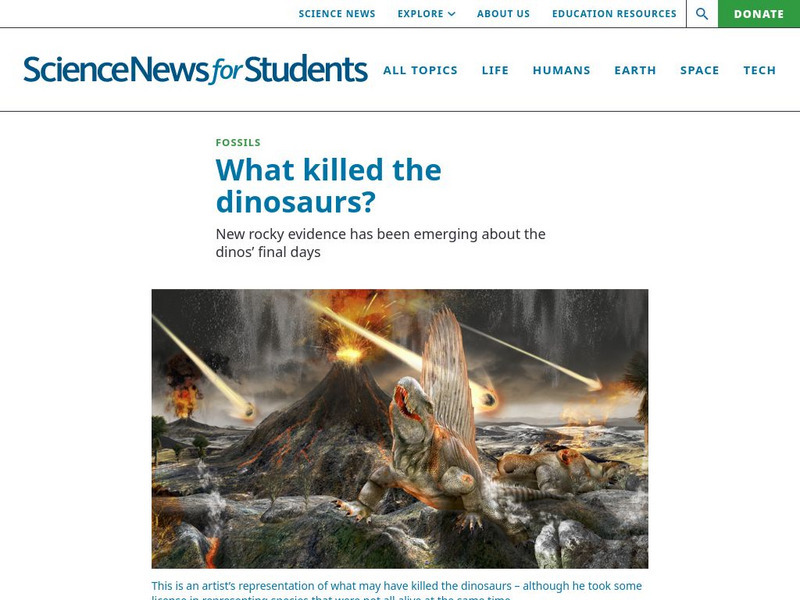Hi, what do you want to do?
NASA
Nasa: What Is a Planet?
This lesson teaches students about the characteristics of planets, comets, asteroids, and trans-Neptunian objects. After learning about these different things, students then are to debate about a new object that is found in space.
University of Nebraska
Space Geologist: Adriana's Rocks
An engaging and highly-interactive site that highlights six topics related to asteroids. Two famous asteroids are mentioned along with a short discussion on the physical characteristics typical of asteroids.
NASA
Nasa Star Child: Meteoroids (Level 1)
Use this site to find out where falling stars come from. Audio content included. Vocabulary words linked to a glossary of terms. Printable version available.
E-learning for Kids
E Learning for Kids: Science: Madagascar: What Is the Solar System?
Patrick loves being a pirate, but he'd prefer to be an astronomer. Join him, and learn about everything high in the sky like the moon, stars, and asteroids.
TED Talks
Ted: Ted Ed: Earth's Mass Extinction
Asteroid strikes get all the coverage, but "Medea Hypothesis" author Peter Ward argues that most of Earth's mass extinctions were caused by lowly bacteria. The culprit, a poison called hydrogen sulfide, may have an interesting...
NASA
Nasa: Space Place: Why Is the Moon So Scarred With Craters?
Find out about why Earth's moon is full of craters, and what happens to asteroids and meteors when they come into contact with Earth.
Famous Scientists
Famous Scientists: Clyde Tombaugh
Find out about Clyde Tombaugh, the scientist who discovered the dwarf planet Pluto in 1930, and also discovered a number of asteroids.
NASA
Nasa: Hubble Observations Shed Light on Jupiter Impact
Scientists continue to learn from their observations long after the largest collision in history was recorded. Was Comet SL-9 actually an asteroid? What were the dark impact clouds made of? What were the effects on Jupiter's magnetic field?
Smithsonian Institution
National Museum of Natural History: Paleobiology: Blast From the Past!
Examine evidence of a deep-sea core that provides evidence of an asteroid impact sixty-five million years ago, which may have contributed to the extinction of the dinosaurs.
Teachers TryScience
Teachers Try Science: Comet Cratering
Use marbles to discover how comets and asteroids make impact craters. This hands-on experiment is easy to do and gives you many variations to try. Included are links to additional information.
Australian Broadcasting Corporation
Australian Broadcasting Corporation: News in Science: Piece of Dinosaur Extinction Asteroid Puzzle Recovered
The first meteorite fossil discovered in this period when tests can be run on it, was found at Chicxulub in Northeastern Yucatan, Mexico. Scientists believe it is part of the meteorite which made the dinosaurs extinct.
E-learning for Kids
E Learning for Kids: Science: Antarctica/ What Are the Different Parts of the Universe?
In this lesson, students learn about objects in the universe, including constellations, planets, meteors, asteroids, and comets.
E-learning for Kids
E Learning for Kids: Science: Seychelles: What Is the Solar System?
In this lesson, students learn about the planets, their moons, asteroids, comets, and dwarf planets in our solar system.
National Earth Science Teachers Association
Windows to the Universe: Origin of Jupiter's Rings
University of Michigan and Windows to the Universe offers information showing that with the help of the Galileo spacecraft, scientists figured out that the rings are made from dust that was kicked off of the small moons surrounding...
National Earth Science Teachers Association
Windows to the Universe: Our Solar System
Our solar system is filled with a wide assortment of celestial bodies - the Sun itself, our eight planets, dwarf planets, and asteroids - and on Earth, life itself! The inner solar system is occasionally visited by comets that loop in...
Nine Planets
The Nine Planets: Small Bodies
This site explores the smaller bodies in the solar system, namely the various asteroids and comets. Links are also provided for additional information on related subjects.
Space Telescope Science Institute
Hubble Site: Solar System Images
A listing of clickable images of objects in the Solar System from the Hubble telescope that includes the following: Venus, Mars, Jupiter, Jupiter's satellites, Saturn, Saturn's rings and satellites, Uranus, Uranus' rings and satellites,...
NASA
Nasa: Our Solar System Overview
This site has links to all the planets, providing an overview of the solar system. It also contains information about asteroids, meteors, comets and other features of our solar system.
University of Texas at Austin
The University of Texas Mc Donald Observatory: Meteorites
Discover fascinating facts about meteorites, pieces of asteroids that originate in outer space and survives their passage through the atmosphere to reach the ground.
PBS
Pbs Teachers: The Doomsday Asteroid
Investigate crater force, size, and mass of objects that strike a surface through a simulation of crater impacts.
NASA
Nasa Star Child: The Solar System
Discover information about parts of the Solar System, along with definitions just by clicking on highlighted vocabulary terms. Be sure to try the "Solar System Activities" to review the material from these pages.
NASA
Nasa Star Child: Star Child
StarChild from NASA defines and describes the Solar System in a simple and easy-to-understand manner. The website is broken down into two versions for the student, grade school and junior high.
Society for Science and the Public
Science News for Students: What Killed the Dinosaurs?
Researchers are beginning to find data implicating that an asteroid impact and supervolcanoes might have been the beginning of the end of dinosaurs on Earth.
Curated OER
Asteroid
The first meteorite fossil discovered in this period when tests can be run on it, was found at Chicxulub in Northeastern Yucatan, Mexico. Scientists believe it is part of the meteorite which made the dinosaurs extinct.
Other popular searches
- Asteroids Comets and Meteors
- Comets and Asteroids
- Comets Meteors Asteroids
- Comets Asteroids
- Meteors and Asteroids
- Comets Asteroids Meteoroids
- Comets, Meteors, Asteroids
- Comets,meteoroids, Asteroids
- Moons, Comets, Asteroids
- Asteroids, Comets, Meteors
- Asteroids Meteorites






